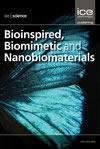微生物合成纳米硒和纳米二氧化钛:亚硒酸盐呼吸机制
IF 0.6
4区 工程技术
Q4 ENGINEERING, BIOMEDICAL
引用次数: 0
摘要
背景:近几十年来,与非纳米材料相比,纳米金属独特的物理化学性质引起了许多研究。纳米二氧化钛主要应用于新型植入物。此外,含硒化合物的结构在这些元素的生物活性中起着关键作用。根据最近的研究,纳米硒不仅毒性较小,而且比Se4+和Se6+等硒离子具有更高的生物活性。方法:由于化学技术的缺陷,研究人员已转向绿色纳米结构合成。本文综述了近年来微生物合成纳米硒和纳米二氧化钛的研究进展。结果:尽管有许多关于绿色纳米颗粒生产的研究文章,但很少提供关于钛和硒纳米颗粒的微生物形成的信息。本文综述了硒呼吸产生纳米硒的可能机制。尽管有关于这些颗粒的微生物合成的报道,但益生菌生产这些颗粒具有很大的价值。结论:考虑到益生菌与免疫系统的兼容性及其在医学上的巨大应用,建议将其与纳米二氧化钛和纳米硒分别用于植入支架和食品添加剂等不同用途。本文章由计算机程序翻译,如有差异,请以英文原文为准。
Microbial synthesis of nano-selenium and nano-titanium dioxide: mechanisms of selenite respiration
Background: The unique physicochemical properties of nano-metals compared to non-nano materials has led to many investigations in recent decades. Nano-Titanium dioxide has been chiefly applied in novel implant forms. In addition, the structures of Selenium-containing compounds play a critical role in the biological activity of these elements. According to recent studies, nano-Selenium is not only less toxic but also has higher biological activity than Selenium ions such as Se4+ and Se6+. Methods: Researchers have turned to green nano-structure synthesis due to drawbacks of chemical techniques. This article presents a literature review on recent advances in microbial synthesis methods to produce nano-Selenium and nano-Titanium dioxide. Results: Despite numerous research articles on green nanoparticle production, little information has been provided on the microbial formation of Titanium and Selenium nanoparticles. This review article focuses on the possible mechanism of nano-Selenium production by Selenium respiration. Although there are reports of microbial synthesis of these particles, their production by probiotic bacteria is of great value. Conclusion: Considering the compatibility of probiotic bacteria with the immune system and their tremendous applications in medicine, it is suggested to use them in combination with nano-Titanium dioxide and nano-Selenium for various ends such as implant scaffolds and food additives, respectively.
求助全文
通过发布文献求助,成功后即可免费获取论文全文。
去求助
来源期刊

Bioinspired Biomimetic and Nanobiomaterials
ENGINEERING, BIOMEDICAL-MATERIALS SCIENCE, BIOMATERIALS
CiteScore
2.20
自引率
0.00%
发文量
12
期刊介绍:
Bioinspired, biomimetic and nanobiomaterials are emerging as the most promising area of research within the area of biological materials science and engineering. The technological significance of this area is immense for applications as diverse as tissue engineering and drug delivery biosystems to biomimicked sensors and optical devices.
Bioinspired, Biomimetic and Nanobiomaterials provides a unique scholarly forum for discussion and reporting of structure sensitive functional properties of nature inspired materials.
 求助内容:
求助内容: 应助结果提醒方式:
应助结果提醒方式:


